#Colinus virginianus
Photo

Northern Bobwhite
364 notes
·
View notes
Text
BOTD: Northern Bobwhite

Photo: Andy Morffew
"The only native quail in the east. Its whistled bob-white! call is a familiar sound in spring in farmland and brushy pastures. The birds are heard more often than seen; although not especially shy, they often keep within dense low cover. During fall and winter, bobwhites live in coveys, averaging about a dozen birds. At night they roost on the ground in circles, tails pointed inward, heads pointed out."
- Audubon Field Guide
#birds#northern bobwhite#birds of north america#north american birds#quail#quails#landfowl#bobwhites#birds of the us#birds of mexico#birds of the caribbean#birds of canada#birds of america#american birds#bird watching#birdblr#birblr#bird of the day#Colinus virginianus
24 notes
·
View notes
Photo
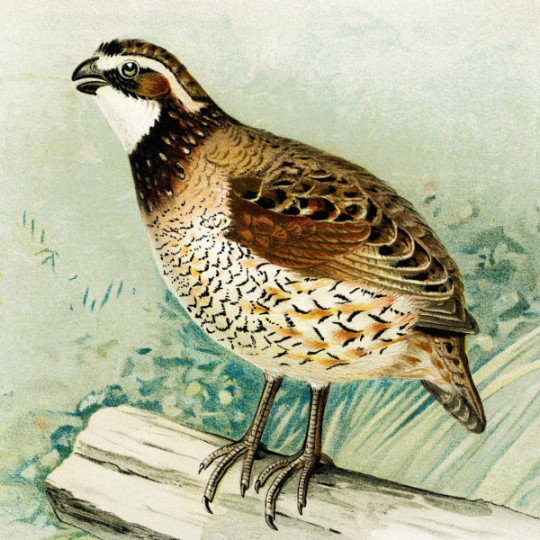
A new variant has been added!
Northern Bobwhite (Colinus virginianus)
© John Livzey Ridgway
It hatches from black, bold, brown, brushy, colored, consistent, dark, distinctive, eastern, heavy, intricate, native, rotund, small, striking, and white eggs.
squawkoverflow - the ultimate bird collecting game
🥚 hatch ❤️ collect 🤝 connect
3 notes
·
View notes
Text
A Little Catching Up Part 2...
A Little Catching Up Part 2…
Lotus corniculatus (Bird’s Foot Trefoil) on Brandon Road along the south side of Farrington Park on 6-12-22, #890-36.
Hello everyone! I am back again with part two. It has been very hot but we had a little more rain which cooled things down a bit for a couple of days. It will be in the upper 90’s again this week. It’s OK as long as I can keep working in the shade and there is a little…
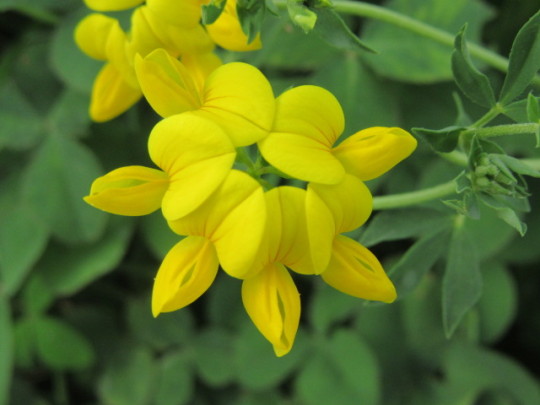
View On WordPress
#Anemone virginiana (Tall Thimbleweed)#Asclepias syriaca (Common Milkweed)#Callirhoe involucrata (Winecup Mallow)#Colinus virginianus (Northern Bobwhite Quail)#Entodon seductrix (Seductive Entodon Moss)#Erigeron divaricatus (Dwarf Conyza or Dwarf Fleabane)#Euphorbia davidii (David&039;s Spurge)#Galium circaezans (Forest or Licorice Bedstraw)#Hemerocallis fulva (Orange Day-Lily)#Hypericum perforatum (Common St. John&039;s Wort)#Mimosa nuttallii (Catclaw Briar)#Parietaria pensylvanica (Pennsylvania Pellitory)#Plagiomnium cuspidatum (Woodsy Thyme-Moss)#Sanicula canadensis (Black Snakeroot)#Sceptridium dissectum (Cutleaf Grapefern)#Silene stellata (Starry Campion)#Tragopogon dubius (Yellow Salsify)#Triodanis perfoliata (Clasping Venus&039;s Looking Glass)
0 notes
Text

Northern Bobwhite Quail (Colinus virginianus), male, family Odontophoridae, order Galliformes, found in the central and eastern U.S., and eastern and central Mexico.
photograph by John Magera/USFWS
#quail#bobwhite#colinus#odontophoridae#galliformes#bird#ornithology#animals#nature#north america#mexico
647 notes
·
View notes
Text
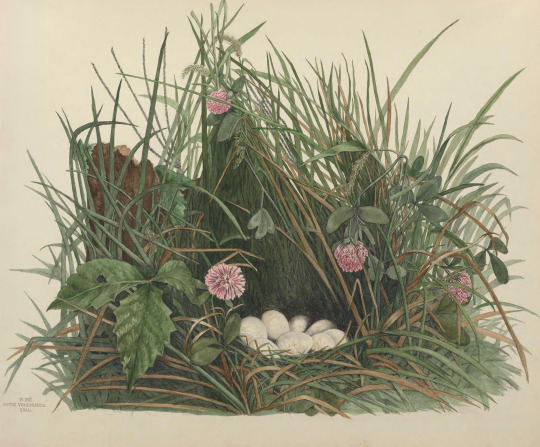
Northern Bobwhite Nest
Nest of the Northern Bobwhite (Colinus virginianus), which is also known as the Virginia quail or bobwhite quail. This ground-dwelling bird likes grassy fields and piney woodlands, and its call sounds like "bob WHITE!"
SciArt by Virginia Smith Jones for the Illustrations of the Nests and Eggs of Birds of Ohio, Vol. 1 (1886). View more beautiful illustrations from this book in Biodiversity Heritage Library with thanks to Smithsonian Libraries and Archives for digitizing.
#sciart#histsciart#bhlib#naturalhistory#ornithology#bobwhite#birds#birds nests#women in science#women in art
118 notes
·
View notes
Photo

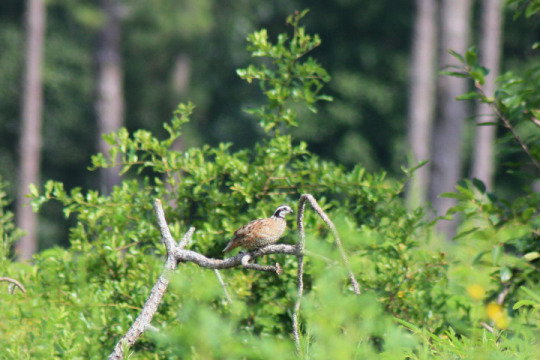
Thriving With Fires The northern bobwhite (Colinus virginianus) quail is known as a fire bird. With a round body, dappled feathers, and distinct whistle, the charismatic quail thrives in the frequently burned pine wood savannas and open forests of the U.S. Southeast. In March 2023, burning in the region was under way. In the Southeast, fire has long been used as a tool to manage pine forests and forest undergrowth. Prescribed (or controlled) burns are conducted in spring to improve natural plant and animal communities. The fires also prevent the accumulation of pine needles and underbrush which may feed more uncontrolled wildland fires. On March 14, 2023, the Moderate Resolution Imaging Spectroradiometer (MODIS) on NASA’s Aqua satellite acquired this image of smoke streaming from several fires in Alabama, Georgia, and northern Florida. Red dots indicate the locations of active fire detections observed by the Visible Infrared Imaging Radiometer Suite (VIIRS) on the NASA-NOAA Suomi NPP satellite. Some of the fires were likely prescribed burns planned and implemented by state and national forest management agencies. “Most landscapes in North America are fire-adapted,” said Jessica McCarty, the associate program manager of NASA’s Applied Sciences Wildland Fire program and branch chief of biospheric sciences at NASA’s Ames Research Center. “These prescribed burns benefit a lot of different species, from trees to birds and reptiles.” McCarty’s research using MODIS data has found that cropland and prescribed fires were responsible for 77 percent of the total active fire detections within the U.S. and were most abundant in the South and Southeast. An example of a fire-dependent species is the Table Mountain pine (Pinus pungens), native to the Appalachian Mountains. Table Mountain pine have serotinous cones, which are glued shut with a strong resin. Only when fire sweeps through the forest does the resin melt, opening the cone and releasing seeds to the environment for reproduction. Other pines, such as the longleaf pine, need an open canopy and bare ground for saplings to survive, making them dependent on frequent fires. In the MODIS image, smoke can be seen coming from the Talladega National Forest in the southern foothills of the Appalachian Mountains. According to the U.S. Forest Service, a prescribed burn of 1,200 acres in the Oakmulgee District of the forest was planned for March 14. The Oakmulgee District of the Talladega is home to Alabama’s largest contiguous longleaf pine forest. Another plume of smoke can be seen coming from Conecuh National Forest, near Alabama’s southern border. The Forest Service planned a prescribed burn on March 14 of 3,299 acres within the forest. Fires in southeastern pines limit the density of the trees in the forest, allowing for growth of grass and flowering plant (forb) species well-suited for bobwhite quail nesting and cover. “Prescribed burns typically occur in Georgia during the transition from the dormant season to the growing season, in March and April, to stimulate lush vegetation for brood-rearing bobwhites,” said David Weber, a research assistant at the University of Georgia and the Tall Timbers research station. Weber has been studying the effects of prescribed fire on the bobwhite quail and recently found that frequent burning (typically every one to two years) promoted healthy quail populations. NASA Earth Observatory image by Lauren Dauphin, using MODIS data from NASA EOSDIS LANCE and GIBS/Worldview and VIIRS data from NASA EOSDIS LANCE, GIBS/Worldview, and the Suomi National Polar-orbiting Partnership. Bobwhite quail photo by Jessica Mohlman, University of Georgia Gamebird and Managed Ecosystems Lab. Story by Emily Cassidy.
2 notes
·
View notes
Video
Northern Bobwhite by Coyoty
Via Flickr:
Colinus virginianus. At the National Aviary in Pittsburgh, PA.
#National Aviary#Pittsburgh#Pennsylvania#PA#zoo#aviary#nature#animal#fauna#bird#avian#bobwhite#Northern bobwhite#wild#life#wildlife#biodiversity#square#square format#Animal Planet#Colinus virginianus#flickr
5 notes
·
View notes
Text
.
“Colinus virginianus, odontophoridae”
Codorniz de Virginia, codorniz cotuí de coyolco o colin de Virginia.
.
.
.
.
.
.
.
.
.
.
.
.
.
#photography #photographer #photo #photoshoot #photoshop #photographylovers #photoshooting #bird #birds #birdphotography #birdsofinstagram #birds_captures #birdsofprey #birdwatching #birdlovers #codorniz #codornices #codorniu #codornizes #codornizcaliforniana #cameraraw #canonphotography #canon #canon📷 #canonmexico #canonméxico
instagram
0 notes
Text

This little bobwhite quail chick fell asleep in my hand!
#birb#birblr#bird#bobwhite quail#virginia quail#georgia giant#colinus virginianus#quail#new world quail#cute#sleepy#they just hatched#asleep#soft#they just hatched a few hours ago#baby#chick
133 notes
·
View notes
Photo

Northern Bobwhite (Colinus virginianus)
© Lynette Spence
44 notes
·
View notes
Photo

Northern Bobwhite (Colinus virginianus)
© Eric Bodker
9 notes
·
View notes
Photo

day 286, a bobwhite quail for @quailsandfriends.
Requests for birds are open!
[project tag]
Want to help support this challenge?
[commissions] | [kofi]
96 notes
·
View notes
Photo


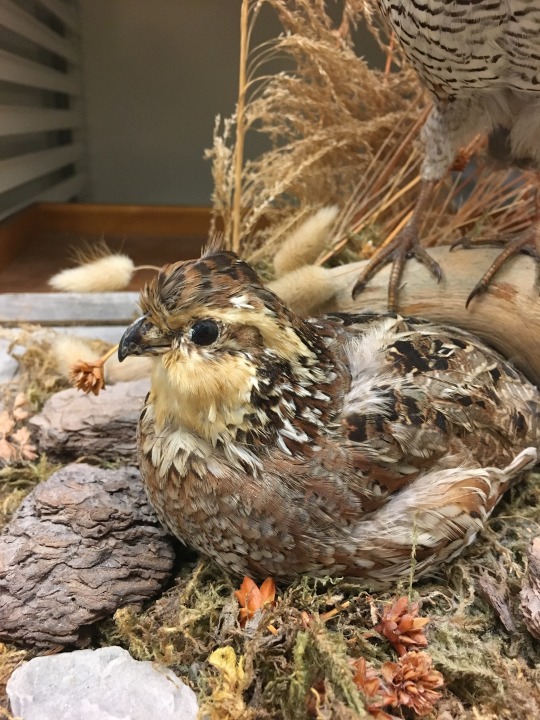
Northern Bobwhites (Colinus virginianus) do everything in life on the ground. The feed on the ground, they nest on the ground; honestly, it’s a bit amazing that they bother with wings anymore. This means that these birds have to blend into the litter layers of North American grasslands. The female, like in many species, does a much better job of blending in. But where they are a buff color, males have bright white instead.
This taxidermy display does a great job incorporating animal behavior and landscape knowledge to show off these birds’ lives. The male is standing for the world to see, the female is almost hidden by the colors of the surrounding plants. Taxidermy displays can be such a great educational tool, and it’s always great to find more hiding away in our cabinets!
Photo credit: Ash Boudrie
#northern bobwhite#colinus virginianus#taxidermy#birds#zoology#ornithology#museum studies#museum collections#museum specimen
123 notes
·
View notes
Photo

"Male Northern Bobwhite" Colinus virginianus by Gary Helm https://flic.kr/p/2k3ZABA
11 notes
·
View notes
Photo

Bobwhites, Colinus virginianus
#bobwhite#quail#birds#bird art#art on tumblr#illustration#nature#wildlife art#inkscape#photoshop#digital art
71 notes
·
View notes